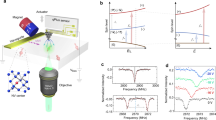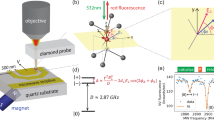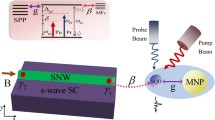We fabricate a quantum magnetic field sensor based on the silicon vacancy centers in 6H–SiC using atomic force microscopy technique. The quantum sensing is based on optically detected magnetic resonance. To implement quantum scanning microscopy, we attach a single 6H–SiC nanoparticle on the tip of the atomic force microscopy cantilever. Our quantum sensors are characterized using optical spectroscopy and electron microscopy. The use of such probes significantly reduces the cost of a quantum sensor and enables the extension of quantum scanning microscopes to physiological and conductive environments.
Similar content being viewed by others
Avoid common mistakes on your manuscript.
INTRODUCTION
Spin defects in semiconductors are widely used for magnetic field sensing at the nanoscale. The most prominent example is the nitrogen-vacancy (NV) center in diamond, which is already being commercialized for a variety of applications, including magnetic domain imaging [1] and visualization of electrical currents [2]. The sensing principle is based on the optically-detected magnetic resonance (ODMR) spectroscopy and requires application of resonant microwave (MW) fields with simultaneous measurement of the fluorescence intensity. Diamond probes are usually handmade and mounted on conventional atomic force microscope (AFM) cantilevers made of other materials. Very recently, intrinsic defects in silicon carbide (SiC) emerged as serious candidates for sensing applications beyond diamond. SiC hosts spin centers (\({{V}_{{{\text{Si}}}}}\)), particularly silicon vacancies [3] and divacancies [4], which can be coherently controlled at room temperature [5, 6], possess a long coherence time in the ms range [7, 8], reveal single-photon emission [7, 9, 10] with a spectrally narrow zero-phonon line [11, 12], and show integrability into electronic and photonic circuits [13–16]. Further, these spin centers in SiC permit all-optical, MW-free magnetometry (effect of level anticrossing) [17]. In particular, a MW‑free approach allows measuring in electrically conducting environments, such as integrated circuits or biological solutions, and avoids spurious excitation or heating by MW radiation. In spite of the obvious advantages, MW-free scanning magnetometry based on the SiC platform has not been realized so far. In this article, we demonstrate the use of SiC nanoparticles with vacancy spin centers in combination with commercial AFM cantilevers.
EXPERIMENTAL SETUP AND SAMPLE
The complete fabrication route for an AFM probe carrying a single SiC nanoparticle at the tip is shown in Fig. 1. We fabricated the nanoparticles from a 2‑inch 6H–SiC wafer. This wafer was cut into 500 × 500 μm pieces before milling, see Fig. 1a. Milling of SiC particles was carried out using a Pulverized 5 planetary mill. For the first stage, a glass and balls of zirconium dioxide with a diameter of 5–15 mm (dry milling) were used. And for the second stage, ZIRCONOX zirconium dioxide balls with a diameter of 0.4–2 mm in an aqueous suspension were used. SiC nanoparticle size distribution was obtained by dynamic light scattering measurements with a Zetasizer ZS 3600. The distribution of the nanometer fraction of 6H–SiC crystals in the colloid is shown in Fig. 1b. \({{V}_{{{\text{Si}}}}}\) spin centers in the nanoparticles generated by focused ion irradiation (He-ions with an energy of 10 keV and fuse a fluence of 3 × 1014 cm–2), as shown schematically in Fig. 1d. Single SiC nanoparticles with \({{V}_{{{\text{Si}}}}}\) were captured on the tips of commercial AFM probes according to an original technique developed earlier for the manufacture of AFM probes with a submicron spherical particle of a calibrated curvature radius [18], shown schematically in Fig. 1e. The presence of SiC nanoparticles verified on AFM probe using a scanning confocal microscope and scanning electron microscope. An example of an electron microscope image of an AFM probe with an SiC nanoparticle is shown in Fig. 1f.
(Color online) Route of fabrication of an AFM probe carrying a single SiC nanoparticle with \({{V}_{{{\text{Si}}}}}\) on the tip. (a) Optical photograph of square submillimeter fragments of a 6H–SiC monocrystalline plate prepared for milling. (b) Size distribution of nanoparticles in the colloid. (c) Deposition of colloidal particles on a substrate. (d) Creation of \({{V}_{{{\text{Si}}}}}\) in nanoparticles by irradiation with helium ions. (e) Capture of a single SiC nanoparticle with \({{V}_{{{\text{Si}}}}}\) at the tip of a commercial AFM probe. (f) Control SEM images of the modified nano-SiC AFM probe.
To perform spatially resolved Raman scattering experiments, we used a laser with a wavelength of λ = 532 nm and a power of \(P = 5{\kern 1pt} \) mW. The laser was focused using a 100× objective with a numerical aperture of NA = 0.7 precise high-speed scanning galvanometer mirror positioning \(XY\) system. The Raman spectra were recorded with a thermoelectrically cooled charge-coupled device (CCD) camera and a monochromator equipped with a 2400-grooves-per-millimeter grating with a spectral resolution. A monochromator with APD detector and a photon counting module was used to record the photoluminescence spectra with central wavelength of 900 nm.
EXPERIMENTAL RESULTS
The method of functionalizing a cantilever AFM probe by mounting a SiC nanoparticle with \({{V}_{{{\text{Si}}}}}\) centers to its tip consists of two steps. First, nanoparticles were evenly distributed on a flat and solid Si wafer such that they were isolated from each other on average by distances corresponding to the diffraction limit of an optical microscope. An example of this distribution is seen in Figs. 2a and 2b, where an area of 50 by 50 μm has freestanding nanoparticles. Second, the nanoparticles should be retained on the substrate and withstand the action of a certain threshold force. The threshold should not be too high so that it remains possible to manipulate particles in contact mode, i.e., to move them along the substrate and capture them on the tip of an AFM probe. Under ambient conditions, the substrate absorbs atmospheric moisture, and the nanoparticle can be retained on it due to capillary forces. To capture on the probe, it is necessary to tear off the nanoparticle from the substrate. To estimate the nanoparticle-substrate adhesion force (\({{F}_{A}}\)) can be considered proportional to the nanoparticle perimeter (P):
where σ is surface tension for a water–air surface. With \(\sigma = 0.07{\kern 1pt} \) N/m and \(P = 1{\kern 1pt} \) μm, we obtain \({{F}_{A}} = \) 100 nN. For successful AFM manipulation of the selected nanoparticle, see Figs. 2c and 2d, the interaction force was set approximately at this level. In the tapping mode, the characteristic peak force of the AFM-probe-sample interaction (impact force) is about 1 nN [19]. Therefore, the AFM manipulation was carried out in the contact mode, but the result of the manipulation was controlled in the tapping mode. Nanoparticle was attached to the probe using UV50 urethane-acrylic glue, which hardens upon irradiation with ultraviolet light. The contact angle (α) measured with AFM of this glue on a silicon substrate is about 10 degrees. From the known α, the thickness of the glue can be determined. Considering, for example, a glue drop on the surface has a spherical form diameter d, we obtain an expression for its height \(h = d{\text{tan}}(\alpha {\text{/}}2){\text{/}}2\). In particular, for \(h = 4.4\) μm we obtain d = 100 μm. The viscosity of the glue (6.5 Pa × s) is such that in the tapping mode the relief of the drop surface is visualized, and in the contact mode the AFM probe penetrates into the drop. The glue is usually applied in microscopic quantities, see the image from the scanning electron microscope (SEM), the AFM-probe in the insert to Fig. 3a. After “dipping” the tip of the probe, the height of which exceeds the height of the drop with d = 100 μm, into the drop of glue, the glue does not reach the cantilever, keeping the AFM-probe operational. There are also nanotraces of UV50 on the end itself, which is used to fix the nanoparticle. Validation of nanoparticle capture by the probe can immediately be visualized by rescanning the contact area, as shown in Fig. 3d.
(Color online) Capture of a single 6H–SiC nanoparticle with \({{V}_{{{\text{Si}}}}}\) at the tip of a commercial AFM cantilever. (a) AFM-topography of the Si wafer section with helium ion-irradiated 6H–SiC nanoparticles. (b) Confocal image of the PL signal (at 900 nm, with 532 nm excitation) of the same section. (c) AFM image of the area, inside the blue square on (a) and (b), with the selected object to be captured on the probe. (d) AFM image of the same area after capturing the object at the tip.
(Color online) Evidence of a SiC nanoparticle on the tip of the NSG10 AFM cantilever probe. (a) Confocal PL scanning image of AFM cantilever with 6H–SiC nanoparticles. (b) Confocal Raman shift scanning image of AFM cantilever with 6H–SiC nanoparticles. The white dotted circle represents a 6H–SiC nanoparticle. The inset of (a) shows an SEM image of the AFM probe with 6H–SiC nanoparticle (top view). The white dotted circle represents a 6H–SiC nanoparticle. The yellow dotted line indicates a large drop of on the AFM cantilever. (c) PL spectrum obtained by subtracting the PL spectrum of the Si Wafer from the PL spectrum of the 6H–SiC nanoparticle. (d) Raman spectrum of 6H–SiC nanoparticle fixed on NSG10 (black) and Raman spectrum of 6H–SiC bulk crystal (red).
After attaching the nanoparticle to the tip of the probe, we performed systematic analysis using confocal photoluminescence (PL) and Raman scanning microscopy, as summarized in Fig. 3. Figure 3a shows a spatial PL scan of \({{V}_{{{\text{Si}}}}}\). The dotted lines show the region that corresponds to the highest PL signal, which confirms the successful attachment of a 6H–SiC nanoparticle to the probe. The crystalline quality and 6H polytype are confirmed in a confocal Raman scan, as shown in Fig. 3b. The insert in Fig. 3a additionally shows an image of the nanoparticle on the AFM probe, obtained by SEM. The corresponding PL and Raman spectra taken from the nanoparticle attached to the AFM probe are shown in Figs. 3c and 3d, respectively. For comparison, Fig. 3d shows Raman spectra of the 6H–SiC bulk 6H–SiC crystal and 6H–SiC nanoparticle attached to the tip of a cantilever. There are three Raman phonon modes in the TO Raman region: E2 TO \((x = 1)\), E2 TO \((x = 1{\text{/}}3)\), A1 TO \((x = 0)\), and E1 TO \((x = 0)\), where A1, E1, and E2 are symmetries of phonon modes in Mulliken notation, TO is the transversal optic phonon type, and x is the reduced wave vector of the phonon modes in the basic Brillouin zone. The corresponding phonon modes are shown for each Raman peak [20]. The Raman spectra for the 6H–SiC nanocrystal and bulk crystal were collected with 10 and 250 s accumulation time, respectively.
CONCLUSIONS
To summarize, we have developed a fabrication protocol for quantum sensors compatible with modern scanning microscopes. For this purpose, we have fabricated nanoparticles with \({{V}_{{{\text{Si}}}}}\). Such crystals have been characterized and successfully attached to AFM probes. The presence of \({{V}_{{{\text{Si}}}}}\) was determined by their characteristic PL, and the fact that the nanoparticles are in their original polytype modification as confirmed by Raman spectra. In this case, a single nanoparticle at the tip of the probe should have the magnetometric properties of a bulk crystal.
Quantum microscopes are based on the NV centers in diamond [21]. We propose an alternative quantum magnetometer that can expand the range of applications, including conducting optically transparent media, which has not yet been implemented. The extended application is due to the absence of the need for additional radiofrequency manipulation, as implemented with NV center-based probes [22], and the PL of \({{V}_{{{\text{Si}}}}}\) in the 900 nm region, transparent to most biological materials.
In this article, we specifically concentrate 6H–SiC nanoparticles, since they have 2 types of centers, emitting in the orthogonal directions [23], and the ODMR resonance signal is shifted by 100 MHz. In this regard, this quantum sensor should work successfully with an arbitrary orientation of the nanoparticle on the AFM probe. At the same time, nanoparticles and probes can be fabricated entirely from SiC wafer on an industrial scale, and it is possible that in the future such probes can be successfully installed instead of standard AFM probes with SiC nanoparticles.
REFERENCES
Q.-C. Sun, T. Song, E. Anderson, A. Brunner, J. Förster, T. Shalomayeva, T. Taniguchi, K. Watanabe, J. Gräfe, R. Stöhr, X. Xu, and J. Wrachtrup, Nat. Commun. 12, 1989 (2021). https://doi.org/10.1038/s41467-021-22239-4
A. Nowodzinski, M. Chipaux, L. Toraille, V. Jacques, J.-F. Roch, and T. Debuisschert, Microelectron. Reliab. 55, 1549 (2015).
H. Kraus, V. A. Soltamov, D. Riedel, S. Väth, F. Fuchs, A. Sperlich, P. G. Baranov, V. Dyakonov, and G. V. Astakhov, Nat. Phys. 10, 157 (2014).
A. L. Falk, B. B. Buckley, G. Calusine, W. F. Koehl, V. V. Dobrovitski, A. Politi, C. A. Zorman, P. X. L. Feng, and D. D. Awschalom, Nat. Commun. 4, 1819 (2013).
W. F. Koehl, B. B. Buckley, F. J. Heremans, G. Calusine, and D. D. Awschalom, Nature (London, U.K.) 479, 84 (2011).
V. A. Soltamov, C. Kasper, A. V. Poshakinskiy, A. N. Anisimov, E. N. Mokhov, A. Sperlich, S. A. Tarasenko, P. G. Baranov, G. V. Astakhov, and V. Dyakonov, Nat. Commun. 10, 1678 (2019).
D. J. Christle, A. L. Falk, P. Andrich, P. V. Klimov, J. u. Hassan, N. T. Son, E. Janzén, T. Ohshima, and D. D. Awschalom, Nat. Mater. 14, 160 (2015).
D. Simin, H. Kraus, A. Sperlich, T. Ohshima, G. V. Astakhov, and V. Dyakonov, Phys. Rev. B 95, 161201(R) (2017).
M. Widmann, S.-Y. Lee, T. Rendler, et al., Nat. Mater. 14, 164 (2015).
F. Fuchs, B. Stender, M. Trupke, D. Simin, J. Pflaum, V. Dyakonov, and G. V. Astakhov, Nat. Commun. 6, 7578 (2015).
D. J. Christle, P. V. Klimov, C. F. de las Casas, K. Szász, V. Ivády, V. Jokubavicius, J. U. Hassan, M. Mikael Syväjärvi, W. F. Koehl, T. Ohshima, N. T. Son, E. Janzén, Á. Gali, and D. D. Awschalom, Phys. Rev. X 7, 021046 (2017).
N. Morioka, C. Babin, R. Nagy, et al., Commun. 11, 507 (2020).
F. Fuchs, V. A. Soltamov, S. Väth, P. G. Baranov, E. N. Mokhov, G. V. Astakhov, and V. Dyakonov, Sci. Rep. 3, 1637 (2013).
C. P. Anderson, A. Bourassa, K. C. Miao, G. Wolfowicz, P. J. Mintun, A. L. Crook, H. Abe, J. U. Hassan, N. T. Son, T. Ohshima, and D. D. Awschalom, Science (Washington, DC, U. S.) 366, 1225 (2019).
D. M. Lukin, C. Dory, M. A. Guidry, K. Y. Yang, S. D. Mishra, R. Trivedi, M. Radulaski, S. Sun, D. Vercruysse, G. H. Ahn, and J. Vučković, Nat. Photon. 14, 330 (2020).
M. Niethammer, M. Widmann, T. Rendler, N. Morioka, Y.-C. Chen, R. Stöhr, J. U. Hassan, S. Onoda, T. Ohshima, S.-Y. Lee, A. Mukherjee, J. Isoya, N. T. Son, and J. Wrachtrup, Nat. Commun. 10, 1 (2019).
D. Simin, V. A. Soltamov, A. V. Poshakinskiy, A. N. Anisimov, R. A. Babunts, D. O. Tolmachev, E. N. Mokhov, M. Trupke, S. A. Tarasenko, A. Sperlich, P. G. Baranov, V. Dyakonov, and G. V. Astakhov, Phys. Rev. X 6, 031014 (2016).
A. Ankudinov, V. Bykov, I. Nyapshaev, A. Shubin, and O. Safronova, RF Patent (2013) No. 2010 134 186 (2012).
B. O. Shcherbin, A. V. Ankudinov, A. V. Kiyuts, and O. S. Loboda, Phys. Solid State 57, 531 (2014). https://doi.org/10.1134/S1063783414030299
S. Nakashima and H. Harima, Phys. Status Solidi A 162, 39 (1997).
P. Maletinsky, S. Hong, M. S. Grinolds, B. Hausmann, M. D. Lukin, R. L. Walsworth, M. Loncar, and A. Yacoby, Nat. Nanotech. 7, 320 (2012). https://doi.org/10.1038/nnano.2012.50
E. Schaefer-Nolte, F. Reinhard, M. Ternes, J. Wrachtrup, and K. Kern, Rev. Sci. Instrum. 85, 013701 (2014). ; PMID: . https://doi.org/10.1063/1.4858835
I. D. Breev, Z. Shang, A. V. Poshakinskiy, H. Singh, Y. Berencén, M. Hollenbach, S. S. Nagalyuk, E. N. Mokhov, R. A. Babunts, P. G. Baranov, D. Suter, S. A. Tarasenko, G. V. Astakhov, and A. N. Anisimov, npj Quantum Inf. 8, 23 (2022). https://doi.org/10.1038/s41534-022-00534-2
ACKNOWLEDGMENTS
We are grateful to Georgy Astakhov for stimulating discussions.
Funding
This work was performed under the ERA.Net RUS plus program and was supported by the Russian Foundation for Basic Research, project no. 20-52-76010. He implantation was supported by the Ion Beam Center (IBC), Helmholtz-Zentrum Dresden-Rossendorf. A.N. Anisimov acknowledges the support of the Council of the President of the Russian Federation for State Support of Young Scientists and Leading Scientific Schools (project no. SP-2179.2021.5). The data that support the findings of this study are available from the corresponding author upon reasonable request.
Author information
Authors and Affiliations
Corresponding author
Ethics declarations
The authors declare that they have no conflicts of interest.
Rights and permissions
Open Access. This article is licensed under a Creative Commons Attribution 4.0 International License, which permits use, sharing, adaptation, distribution and reproduction in any medium or format, as long as you give appropriate credit to the original author(s) and the source, provide a link to the Creative Commons license, and indicate if changes were made. The images or other third party material in this article are included in the article’s Creative Commons license, unless indicated otherwise in a credit line to the material. If material is not included in the article’s Creative Commons license and your intended use is not permitted by statutory regulation or exceeds the permitted use, you will need to obtain permission directly from the copyright holder. To view a copy of this license, visit http://creativecommons.org/licenses/by/4.0/.
About this article
Cite this article
Likhachev, K.V., Breev, I.D., Kidalov, S.V. et al. 6H–SiC Nanoparticles Integrated with an Atomic Force Microscope for Scanning Quantum Sensors. Jetp Lett. 116, 840–845 (2022). https://doi.org/10.1134/S0021364022602251
Received:
Revised:
Accepted:
Published:
Issue Date:
DOI: https://doi.org/10.1134/S0021364022602251







